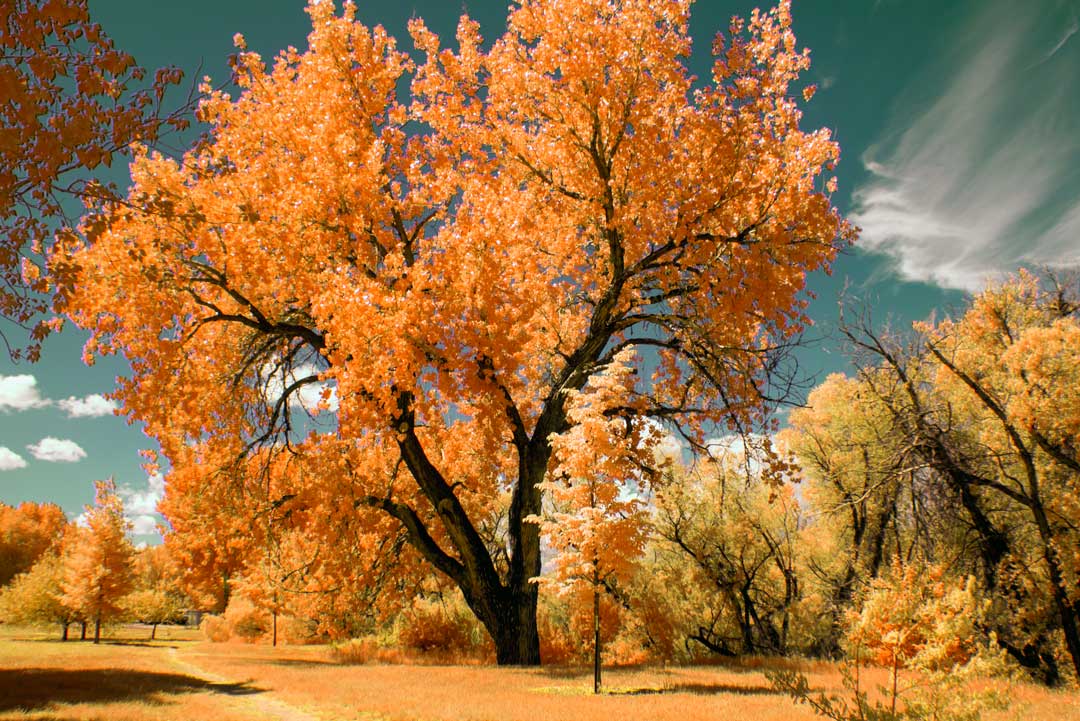Today’s Post by Joe Farace
It is only with the heart that one can see rightly; what is essential is invisible to the eye.—Antoine de Saint-Exupery
Astronomers have long delved into the infrared spectrum for astrophotography of distant non-terrestrial subjects but there are plenty of terrestrial applications for infrared photography too, including forensic investigation and aerial crop or forest surveys. My personal philosophy is that photography should be fun. Part of having fun is trying new things. Digital IR photography is lots of fun because it helps you look at your world in a new way and lets you create images that look unlike any other technique that you’re likely to try. That alone is a good enough reason to try infrared digital photography.

How I Made this Photo: I photographed my favorite tree in McCabe Meadows, near Parker. Colorado with a used Panasonic Lumix GX1 that I bought from Roberts Camera and then had converted to infrared capture with Life Pixel’s Hyper Color filter. The lens used was an Olympus M.Zuiko 17mm f/2.8. Exposure was 1/2500 sec at f/5 that appears (for some reason) to have made in Program mode, not my normal and preferred Av mode, with an aperture of f/11 or f/16. The RAW files was processed using one of Life Pixel’s proprietary Photoshop actions. Those are not fall colors; this photograph was made in May!
Every photographer knows about visible light but there are other kinds of light we can’t see. What you see as red, orange, yellow, green, blue, indigo, and violet are different wavelengths of light. Shorter waves are blue and the longer ones appear red to our eyes. Every color’s wavelength is measured in nanometers or one billionth of a millimeter or microns that are a millionth of a meter. Red light begins at wavelengths of about 0.65 microns. Violet light has wavelengths around 0.4 microns and yellow light waves are 0.6 microns. Your eyes can’t see light with a wavelength that’s longer than 0.7 microns. We also experience thermal infrared light when we feel the sun’s heat of the on our skin.
For the purpose of this blog and in my personal photography, light with wavelengths from 700 and 900 nm are referred to as infrared light. This band of infrared light is a thousand times wider than that of visible light and is completely invisible to our eyes. Infrared film and some video cameras are sensitive to what is called near infrared. This is also the type of IR light that your television remote control *uses.
Geek Alert: Ultra Violet (UV) light comes from the Sun but the Earth’s ozone layer (don’t go there…) protects us from most of this light. Many photographers keep UV aka Haze filters on all of their lenses as protection but they will also reduce the amount of ultraviolet radiation striking the image sensor or film and suppress atmospheric haze or dust. When photographing at high altitudes of 14,000 feet or more, you really need a UV filter in front of your lens to approximate the same color correct view that your brain send to your eyes.
My book, The Complete Guide to Digital Infrared Photography is available from Amazon for with new copies selling for $45.09 with used copies starting around nine bucks as I write this. Creative Digital Monochrome Effects has a chapter on IR photography and is available from Amazon with new copies at $21.60 with used copies starting at a little more than two bucks, as I write this. There’s no Kindle version available for either book, sorry.
